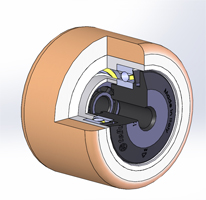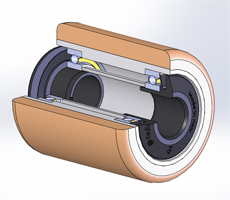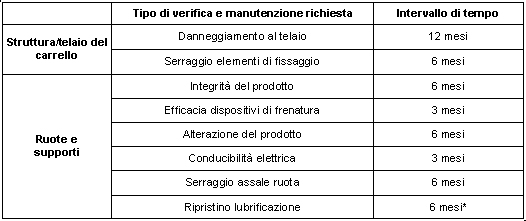
Specifically designed for::
• assembly on electric pallet trucks, both walk-behind model and with operator on board
• ensuring a longer product life under continuous mechanical handling

Technical features
TRACTIVE FORCE
The user must check that the force needed to move the trolley with the intended load is compatible with the applicable regulations in force.
To facilitate the choice of the optimal wheel, also in relation to the force required to move the trolley, the Iberruedas catalogue shows the rolling resistance value of each product.
SPEED
The maximum speed to which the rated carrying capacities stated by Iberruedas refer is 4 km/h (1.1 m/s). For higher speed applications refer to heading 5.4 of this technical manual.
FLOOR
The rated carrying capacity declared by the manufacturer refers to use on smooth and compact floors in good condition. Uneven floors, obstacles and level differences require larger diameter wheels and more elastic tyres (see heading 5.1).
MEANS OF PROPULSION AND MOVEMENT INTENSITY
The rated carrying capacity stated by the manufacturer refers to manual propulsion with interruptions during use. For continuous operation or powered towing refer to the Iberruedas notes.
ENVIRONMENT
The user must check that the construction materials of the selected product are compatible with the physical-chemical conditions in the operating environment (humidity, temperature, aggressive agents etc.). The Iberruedas catalogue shows the "normal" operating conditions for each type of wheel.
ELECTRICAL CONDUCTIVITY
The market offers products that guarantee electric conductivity from the attachment element to the wheel tread.
The electrical resistance of these products is less than 10,000 Ohm, as measured with an ohmmeter or other device designed to measure electrical resistance with 500 Vdc open circuit voltage and with internal impedance such that the output voltage never drops below 50 Vdc when the ohmmeter is connected to an external resistance of 1,000 ohm.
After installation, the user must check electrical conductivity from the trolley to the tread.
BRAKING AND/OR LOCKING DEVICES
The manufacturer of wheels and castors for industrial, institutional and home applications produces castors equipped with brakes and/or locks. These are designed to immobilise the trolley on slopes of no more than 3%, on the condition that at least two of the trolley wheels equipped with such devices are in contact with the ground.
INCORRECT ACTIONS AND MISUSE
For correct use of wheels and castors, the following conditions must be avoided in all circumstances:
- overloads;
- non-uniform load distribution;
- violent application of the load;
- prolonged stationary periods under load;
- impacts and collisions;
- dropping of the trolley due to floor height differences;
- engagement of locks and/or brakes while the trolley is moving;
- moving the trolley with locks and/or brakes engaged;
- parking the trolley with locks and/or brakes engaged on slopes of more than 3%;
- washing with chemically aggressive cleaners;
- replacement of wheel and/or castor with parts that do not comply with the manufacturer's specifications.
STORAGE
The products must be stored in a well-ventilated area, without excessive humidity, with a temperature range of between -10 °C and +40 °C and protected against dust. Never expose products to direct sunlight or atmospheric agents for extended periods of time and, in general, avoid prolonged storage.
For optimal storage and dust protection, Iberruedas products are supplied in standard shrink-wrapped packs.
Wheels and castors must be assembled in full compliance with the assembly cycle defined by the manufacturer for the specific application. Iberruedas can supply pre-assembled wheels and castors. If assembly is carried out by the customer, the manufacturer cannot be held liable for damage or product defects directly attributable to assembly operations performed without complying with the manufacturer's specifications.
WHEEL ASSEMBLY
Check the mechanical strength of the chosen attachment components (axle sets, nuts, washers) in accordance with the type of assembly (projecting or fork) and the projected load value;
Fit the axle set horizontally, perpendicular to the operating direction, and prevent it from rotating;
Check that the nut is tightened on the axle set;
Check that the wheel rotates freely once the assembly operations have been completed.
Iberruedas uses calibrated nut driving tools to ensure the correct tightening torque values are applied to threaded fasteners.
CASTOR ASSEMBLY
The trolley structure must be sized to withstand the stresses to which it will be subjected and guarantee co-planarity of the attachment surfaces. The attachment surfaces shall be flat, horizontal and of a size such as to guarantee that the corresponding mating surface on the castor remains perfectly coplanar in the attachment point.
The use of welding techniques to connect castors to trolleys is to be avoided.
Additional recommendations:
- mount castors with an attachment plate by means of screws, nuts and washers of the size and quantity indicated by the manufacturer;
- tighten nuts or screws to the prescribed tightening torque value;
- in the case of fixed castors, ensure the axle set is perfectly perpendicular to the operating direction;
- ensure castors with a plain stem are attached to tubular structures with precise tolerances;
- secure cross hole type stems with screws of appropriate diameter and length;
- ensure the trolley tubular structure rests completely on the castor attachment plate;
- for castors with a threaded stem, ensure the castor attachment plate adheres completely to the trolley mating surface . Through-hole castors must be attached using screws of the diameter prescribed by the manufacturer.
The user must carry out scheduled maintenance that includes the checks listed below at adequate intervals in accordance with the operating conditions.
EQUIPMENT STRUCTURE CHECKS AND MAINTENANCE
- Check any damage to the trolley frame that may have impaired correct attachment of the product;
- Check that the product fastening devices are correctly tightened on the trolley structure.
WHEELS AND CASTORS CHECKS AND MAINTENANCE
- Check that the product is intact, fully operational and without excessive play, wear, deformation or tearing;
- Check the efficiency of locking devices and/or brakes, if present;
- Check that the product has not deteriorated due to the environmental conditions (rusting, corrosion, foreign matter, etc.), thus reducing its operating efficiency;
- For products designed to guarantee electrical conductivity, keep the rolling strip clean and periodically perform electrical conductivity tests;
- Check that the wheel axle set is correctly tightened and reapply the prescribed tightening torque if necessary;
- Lubricate moving parts with suitable lubricants in relation to the application.
The following chart shows the maximum time interval between two successive checks. For particularly demanding conditions, the time interval between checks must be evaluated in relation to the specific application.

* = Re-lubricate after each product washing cycle.
PRODUCT DISPOSAL AND RECYCLING
To discard and/or recycle the products at the end of their life cycle, start by separating the wheel+castor assemblies from the equipment on which they are mounted. Dismantle the wheel + castor assemblies into the following components:
- castor
- axle set (screw, tube, nut)
- wheel
It is particularly important to detach the wheels from the castor if the parts in question are prevalently composed of plastic material or aluminium alloy.
Information on the disposal and recycling of the main materials of which Iberruedas wheels and castors are made is provided below. The information given should anyway be considered in conjunction with the procedures and regulations issued by the authority responsible for waste disposal in the region or place of use of the products. Please contact our Sales Department for more information.
Castors and axle sets
- Steel and stainless steel can be recycled as ferrous scrap.
Wheels
We recommend consigning the products to product recycling processes that include preliminary treatments to sort the various construction materials of the wheels, in order to ensure correct disposal and/or recycling of each material type.
- Steel and engineering cast iron can be recycled as ferrous scrap
- Aluminium alloy can be recycled as non-ferrous metal
- Plastic, thermoplastic rubber and vulcanised rubber parts can be recycled once they have been separated from ferrous and non-ferrous metals
- Thermosetting resin can be sent to landfill
- Polyurethane can be sent to landfill once it has been separated from ferrous and non-ferrous metals.
Shrink-wrap packaging is recyclable as low-density polyethylene (PE-LD).
Wooden pallets can be reused or recycled.
Paper or cardboard packaging materials can be returned to the paper production cycle.
With regard to recycling and recovery methods, refer to the waste disposal agencies operating in the countries in which the parts are discarded.
Iberruedas SPA - Società Unipersonale - Via Quattro Passi 15, 41043 Formigine (MO) - Italy - P.IVA/VAT NUMBER IT00180900367 - Capitale Sociale € 3.640.000 i.v - R.E.A. MO nr. 65528 – Reg. Imprese MO nr. 00180900367 Italia: 059 410300-306, E-mail: comm.italia@tellurerota.com - Estero: +39 059 410302, E-mail: comm.estero@tellurerota.com - Fax: +39 059 572859